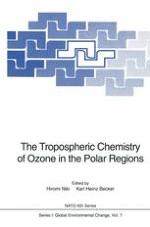1993 | OriginalPaper | Chapter
Hydrocarbons Emission from the Ocean
Author : B. Bonsang
Published in: The Tropospheric Chemistry of Ozone in the Polar Regions
Publisher: Springer Berlin Heidelberg
Included in: Professional Book Archive
Activate our intelligent search to find suitable subject content or patents.
Select sections of text to find matching patents with Artificial Intelligence. powered by
Select sections of text to find additional relevant content using AI-assisted search. powered by
Non-methane hydrocarbons (NMHCs), particularly alkenes oxidized either by ozone, OH and NO3 radicals can have a significant impact on the photochemistry of the remote background atmosphere [Donahue and Prinn, 1990], and are able, in turn, to influence the budget of these oxidants. Strong evidences for a residual tropospheric background hydrocarbons have been reported by several authors working in remote areas [Rudolph and Ehhalt, 1981; Bonsang and Lambert, 1985; Greenberg and Zimmerman, 1984]. Particularly, alkenes despite their high reactivity are found at significant levels from 10 pptv to 100 pptv in the southern hemisphere and even in the antarctic continent far from usual anthropogenic sources [Rudolph et al., 1989]. The existence of a marine production by outgassing of superficial seawater was first reported by Lamontagne et al. [1974] working in the Pacific Ocean, and the origin of light hydrocarbons was ascribed to local emissions from the ocean surface by photochemical degradation of dissolved organic carbon [Wilson et al., 1970]. Beside the chemical aspect linked to the photochemistry of the remote marine atmosphere, non-methane hydrocarbons are useful indicators of air/sea exchange kinetics due to their very different atmospheric lifetimes. Bonsang et al. [1991] have shown recently that it is possible to ascertain from the vertical distribution of NMHC in the atmosphere the existence of fast and non-steady state processes of exchanges between the ocean and the atmospheric boundary layer.
